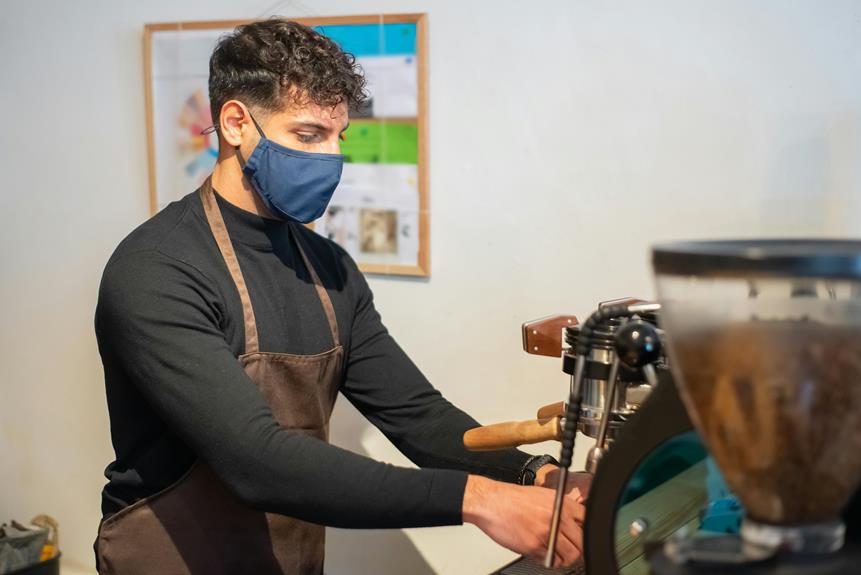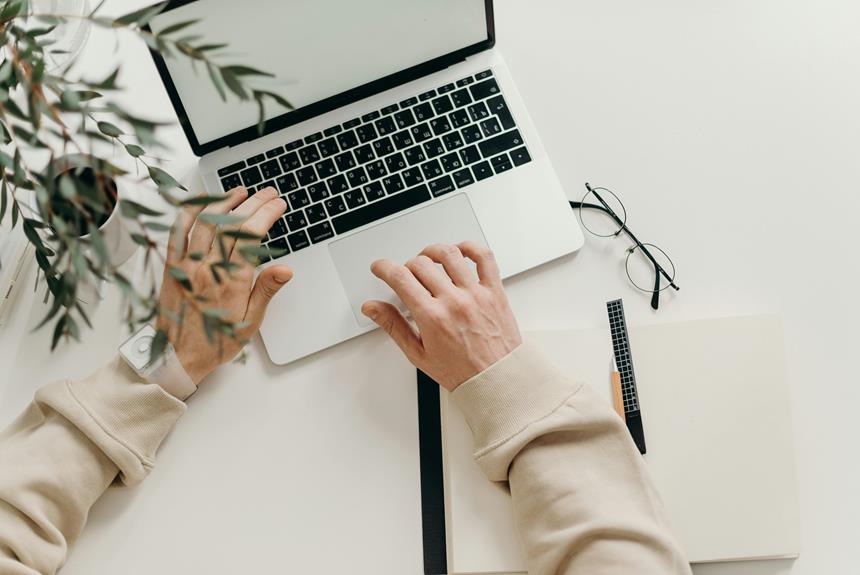You're about to tap into the full flavor potential of your coffee beans with a simple, yet nuanced, coffee dripper brewing process. Start by selecting the right coffee beans, considering origin, roast level, and flavor notes. Grind them just before brewing for maximum flavor, aiming for a medium-coarse grind size. Measure 30-40 grams of coffee for a standard 8-cup dripper and heat water to an ideal temperature between 195°F and 205°F. Assemble the dripper, pour water in a circular motion, and time the brewing process to complete within 3-4 minutes. Now, take the next step to perfect your brewing technique.
Key Takeaways
- Select a medium-coarse grind size and freshly grind coffee beans just before brewing for optimal flavor and aroma.
- Use a digital scale or coffee scoop to measure 30-40 grams of coffee for a standard 8-cup dripper, adjusting for smaller or larger drippers.
- Heat water to an ideal temperature between 195°F and 205°F, and pour it over the coffee grounds in a circular motion to promote even saturation.
- Assemble the coffee dripper according to the manufacturer's instructions, ensuring the paper filter is properly aligned and seated, and the device is clean and free of residual coffee oils.
- Aim to complete the brewing process within 3-4 minutes, adjusting the pace to achieve the desired strength and flavor profile.
Choosing the Right Coffee Beans
When you're on the hunt for the perfect cup of coffee, you start by selecting the right coffee beans. This vital step sets the tone for the entire brewing process.
You'll want to think about two essential factors: bean origin and roast level.
The origin of your coffee beans can greatly impact the flavor profile of your coffee. Beans from regions like Ethiopia and Colombia tend to be bright and fruity, while those from Brazil and Sumatra are often smoother and nuttier. Think about the flavor notes you enjoy and choose a region that aligns with your taste buds.
Next, ponder the roast level. Lighter roasts bring out the coffee's natural acidity and fruit notes, while darker roasts provide a richer, more bitter taste.
If you're new to coffee, a medium roast is a great starting point. It offers a balanced flavor that's not too bright or too bold.
Grinding Coffee for Optimal Flavor
Now that you've selected the perfect coffee beans, it's time to release their full flavor potential by grinding them to the ideal consistency.
Freshly grinding your coffee beans is vital for maximum flavor, as pre-ground coffee can sit on a shelf for weeks or months, losing its flavor and aroma.
Invest in a good quality grinder that can produce a consistent grind size. Blade grinders can generate heat, which can damage the beans and result in a bitter taste. Instead, opt for a burr grinder that produces a consistent grind size and doesn't generate heat.
Regular grinder maintenance is essential to guarantee coffee freshness.
Clean your grinder regularly to prevent any buildup of old coffee oils and residue. This will prevent any stale flavors from affecting your freshly ground coffee.
When grinding your beans, aim for a medium-coarse grind size, which is ideal for a coffee dripper.
Experiment with different grind sizes to find the perfect one for your taste preferences.
Measuring Coffee for Perfect Balance
With a freshly ground medium-coarse grind, you're ready to measure out the perfect amount of coffee for your dripper.
Measuring coffee is vital to achieve the ideal coffee-to-water ratio, which is typically between 1:15 to 1:17. This means for every one gram of coffee, you'll use 15-17 grams of water.
To measure accurately, use a digital scale or a coffee scoop with marked increments. Aim for 30-40 grams of coffee for a standard 8-cup dripper. If you're using a smaller or larger dripper, adjust the amount accordingly.
When it comes to coffee ratios, a general rule of thumb is to use 1 tablespoon of coffee for every 6 ounces of water.
However, this can vary depending on your personal taste preferences and the type of coffee beans you're using. Experiment with different ratios to find your perfect balance.
Having the right measurement tools will guarantee you're consistent in your coffee-making process. Invest in a good digital scale and a coffee scoop, and you'll be well on your way to brewing the perfect cup of coffee.
Heating Water to Ideal Temperature
You'll need to heat water to an ideal temperature between 195°F and 205°F for perfect extraction. This temperature range allows for the ideal extraction of coffee's flavors and oils. Using water that's too hot can burn your coffee, while water that's too cold can result in a weak or under-extracted brew.
To achieve the ideal temperature, consider the following:
- Use a thermometer to monitor the water temperature, ensuring it falls within the desired range.
- Invest in a water purification system to remove impurities and minerals that can affect the taste of your coffee.
- Choose a heating method that allows for precise temperature control, such as an electric kettle or a temperature-controlled pouring kettle.
Avoid overheating the water, as this can lead to a loss of oxygen and a less flavorful cup.
Experiment with different temperatures within the ideal range to find the perfect balance for your coffee beans.
Assembling the Coffee Dripper
Having reached the ideal water temperature, turn your attention to the coffee dripper, which needs to be assembled and prepared for the coffee grounds.
Start by ensuring your dripper is clean and free of any residual coffee oils. If you haven't already, incorporate a regular cleaning routine to prevent any buildup. This can be as simple as washing the dripper with soap and warm water after each use.
Now, place the paper filter in the dripper, making sure it's properly aligned and seated. The type of dripper materials you're using will dictate the specific assembly process, so refer to the manufacturer's instructions if needed.
For most drippers, you'll need to attach the filter holder to the top of the device. Take a moment to inspect the dripper for any signs of wear or damage, replacing any worn-out parts as necessary.
With your dripper assembled and ready, you're one step closer to brewing the perfect cup of coffee. Move on to the next step, pouring water for even saturation, to get the best results from your coffee dripper.
Pouring Water for Even Saturation
Now that your coffee dripper is assembled and ready, pour the heated water over the grounds in a circular motion to promote even saturation. This guarantees all grounds are exposed to the same amount of water, which is vital for a balanced flavor. As you pour, aim for a steady flow to maintain consistent water pressure. This will help prevent channeling, where water flows through the coffee too quickly, resulting in under-extraction.
Water flows from the center of the dripper, spreading evenly to the edges
The grounds are completely saturated, with no dry spots
The water level rises steadily, without sudden surges
You're pouring at a pace that allows for gentle flow control
The sound of the water flowing is steady and smooth, like a gentle hum
Timing the Brewing Process
Timing is crucial in the brewing process, as it directly affects the flavor and strength of your coffee, so aim to complete the process within 3-4 minutes.
You'll want to find a brewing pace that allows for even extraction without rushing or slowing down the process. If you're aiming for a stronger coffee, you can slow down the brewing pace to allow more time for the coffee grounds to steep. On the other hand, if you prefer a lighter coffee, you can speed up the process to reduce the steeping time.
As you wait for the coffee to drip, pay attention to the sound and pace of the dripping.
You should hear a steady, gentle dripping sound, indicating that the water is flowing at the right rate. If the dripping slows down or speeds up noticeably, you may need to adjust the grind of your coffee beans or the amount of water you're using.
Serving and Enjoying Your Coffee
You're left with a freshly brewed pot of coffee, and it's time to pour yourself a cup and savor the flavors you've carefully extracted. This is the moment you've been waiting for – the culmination of your coffee rituals. As you pour the steaming hot coffee into your cup, take a moment to appreciate the aroma and the fruits of your labor.
Find a cozy spot to sit and enjoy your coffee, whether it's on your porch, in your backyard, or at your kitchen table.
Take a sip and notice the flavors and notes that you've carefully crafted.
Savor the warmth of the coffee and the comfort it brings.
Share your coffee with friends or family and enjoy the conversation and company.
Take a moment to reflect on the coffee culture that brings people together and appreciate the simple joys in life.
Frequently Asked Questions
Can I Use a Coffee Dripper to Make Tea or Other Infused Beverages?
You can definitely use a coffee dripper for tea or other infused beverages, but be mindful of flavor profiles and steeping times, as they'll vary greatly from coffee, requiring adjustments for ideal results.
How Often Should I Clean and Descale My Coffee Dripper?
Like a master painter, you must clean and descale your coffee dripper regularly to prevent mineral buildup from tainting your brews. Check your water quality, and aim to descale every 3-6 months to keep your dripper in top shape.
Is It Necessary to Preheat the Coffee Dripper Before Brewing?
You're wondering if preheating your coffee dripper is necessary. Yes, it's essential! Preheating guarantees the dripper reaches the ideal temperature, around 195°F to 205°F, for perfect heating and extract the perfect flavor from your coffee beans.
Can I Use a Paper Filter in a Metal Filter Coffee Dripper?
You're wondering if you can use a paper filter in a metal filter coffee dripper. Yes, you can! This combo offers superior filter quality, and you can also explore filter alternatives like cloth or metal filters for a different flavor profile.
Will a Coffee Dripper Work With a Non-Standard Coffee Mug Size?
You'll need to check your coffee dripper's Mug Measurements to confirm Cup Compatibility, but generally, it'll work with most standard sizes; if not, consider a adjustable dripper or a travel mug with a built-in filter.
Conclusion
You've mastered the art of using a coffee dripper! Now, put your skills to the test.
Remember, the perfect cup is all about balance and harmony.
Take, for instance, Sarah, a busy professional who switched from instant coffee to a dripper.
By following these steps, she noticed a significant improvement in flavor and aroma, and her morning routine was transformed.
With every sip, she felt more energized and focused, ready to tackle the day ahead.









